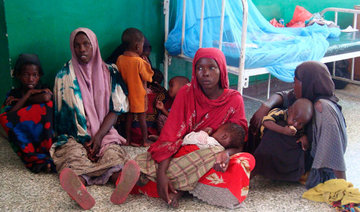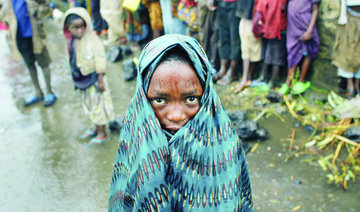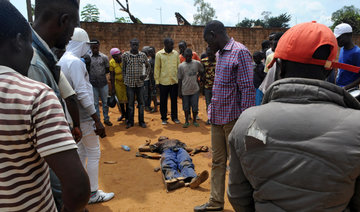ROME: Hunger in the Democratic Republic of Congo has soared in the last year, leaving 7.7 million people in urgent need of food aid and pushing the country closer to famine than it has been in a decade, food security experts said on Monday.
Much of the rise in hunger — 1.8 million new people were added to the list — stems from escalating violence in the Kasai and Tanganyika regions, which in Kasai alone has forced 1.4 million people to flee their homes in the past year.
More than 1.5 million people are now facing “emergency” hunger levels, the Integrated Food Security Phase Classification (IPC), whose members include the UN Food and Agriculture Organization (FAO) and the World Food Programme, said on Monday.
“Emergency” means people are forced to sell possessions and skip or reduce their meals. It is one level below a classification of famine in the IPC’s internationally-recognized five stages of hunger.
“This is the first time in 10 years that we’re so close to level five (famine),” said Alexis Bonte, FAO’s interim representative in Congo.
“It’s a humanitarian tsunami, but it’s a silent tsunami, that’s the problem,” he told the Thomson Reuters Foundation.
Congo now has 3.8 million people displaced within the country, in addition to a steady flow of refugees from neighboring Burundi, Central African Republic and South Sudan.
“It has been hidden by other crises,” Bonte said, referring to South Sudan, Somalia, Nigeria and Yemen.
Land aplenty
The crisis has worsened with the advance of fall armyworm, a crop-eating caterpillar that has spread to many parts of the country, including Kasai and Tanganyika, as well as by outbreaks of cholera and measles.
The country has enough land to feed at least 1 billion people — roughly the population of Africa — and is wealthy in minerals. But grinding poverty and years of conflict have left many of its people chronically hungry.
“I think the donors are really tired of funding the crisis in Congo,” Bonte said, in reference to conflicts that began in the 1990s and have affected millions of people every year since.
The United Nations has received a quarter of the $812.6 million sought in the humanitarian appeal for Congo this year.
While the government needs to stabilize and reduce the conflicts, humanitarian agencies need to be able to give aid, otherwise people are more likely to resume fighting, he said.
“We cannot hope to make change if we abandon the people.”
“These people deserve to live in dignity. They have suffered enough,” he said.
Violence has escalated in Congo since President Joseph Kabila refused to step down after his mandate ended in December.
Scott Campbell, head of Central and West Africa at the UN human rights office, said the violence had spiralled out of control with the complicity of Kabila’s government, and the UN was concerned it could be used to delay a fresh election.
Analysts fear growing fighting could spark a repeat of the conflicts seen between 1996 and 2003, mostly in the east of Congo, in which millions died, mainly from hunger and disease.
Crops bring dignity
Bonte, who has spent seven years in Congo, said the displaced — many of them women — need seeds and farming tools to become self-sufficient, ease pressure on the communities hosting them, and reduce tensions.
When local NGOs in Chikapa, a town in Kasai region, provided farmland for some 2,000 families who had fled their homes earlier this year, and FAO gave farming equipment, they were able to harvest vegetables to eat and sell within weeks.
“Normally in a development project, it would take a year to do this. This was just a few weeks, because the ladies were desperate to do something ... to escape the trauma they had suffered and ... go back to dignity,” Bonte said.














